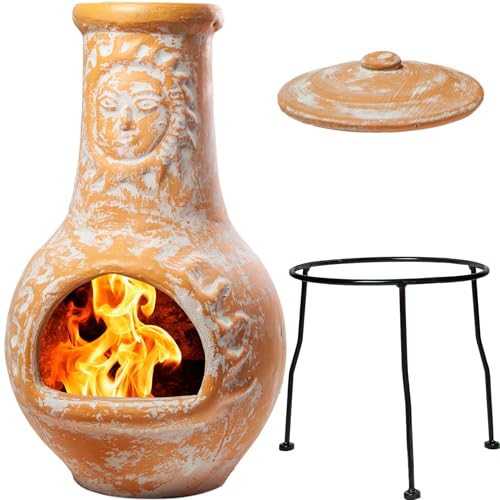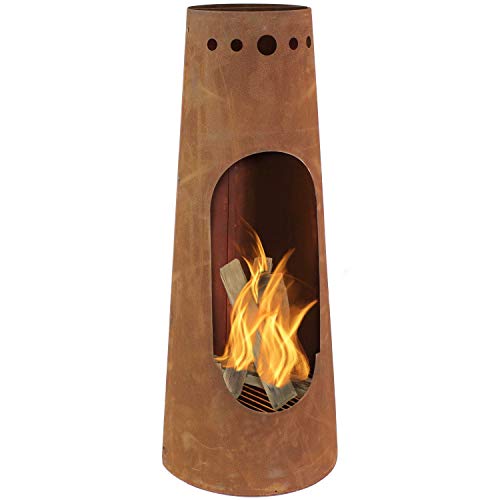자유게시판
| 제목 | Steel Chiminea Tools To Help You Manage Your Daily Lifethe One Steel C… |
|---|---|
| 작성자 | Deandre |
| 조회수 | 14회 |
| 작성일 | 25-01-04 02:26 |
| 링크 |
본문
 Buying a Steel Chiminea
Buying a Steel Chiminea Chiminesas can be an ideal addition to any garden and also brings family and friends together. However, there are a few things to consider before purchasing a chiminea.
Chiminesas can be an ideal addition to any garden and also brings family and friends together. However, there are a few things to consider before purchasing a chiminea.The chiminea, for example, must be placed on an insulated base that is resistant to heat and flame. It must also be kept at away from anything that could catch flames.
Easy to Assemble
You can put together your steel chiminea by simply following the instructions in the manual. These chimineas can be very heavy, and must be handled with caution. It is recommended that you do not place any flammable objects close to the chiminea, as they could be damaged by the extreme temperatures generated by it. It is also better to put the chiminea in a permanent position and on a non-flammable surface, like a patio.
After the chiminea has been assembled, it must be thoroughly cleaned using an electric brush or broom to remove dirt and other debris from the joints. The rusty parts must be sanded down. This will ensure that the paint sticks well and gives a superior finish. Also, the chiminea needs to be completely dry before you start painting. Use a high quality paint that is rust-resistant, such as Rust-Oleum Stove and BBQ paint. It is recommended to apply two coats, allowing for each coat to dry for a few hours before applying the second.
Chimineas are extremely durable However, they require some regular maintenance to stay in good condition. This is particularly relevant in areas with a lot of salt air or moisture. These conditions can speed up the corrosion of the chiminea. It is crucial to protect your chiminea with a anti-rust finish and to clean it frequently.
It is essential to think about the location of your chiminea prior to when you begin the process of assembling it. It is important to avoid placing it in close proximity to flammable materials such as wooden fences and planters, garden lighting, or furniture. Chimineas should be at least six feet away from any other structure or building.
It is also important to cover your Chiminea if it's expected to rain. This will shield it from ice, moisture and other elements that can cause it crack. If you do not have a cover You can also consider covering the chiminea using a sheet or tarp.
Easy to Clean
Using the right cleaning products and following the right care guidelines will ensure that your chiminea made of clay looks great and remains safe to use for many years to be. Clay is a very brittle material and is easily damaged or broken it if not properly cared for. Regularly inspect the chiminea and clean up any debris. This keeps the chiminea looking appealing and reduce the risk of fire hazards resulting from the accumulation of tinder or soot.
Clean the interior of your chiminea by paying special attention to any places that are difficult to reach and crevices. Using a wire brush to clean the interior is the best option, but you can also make use of a cleaning product and a sponge. After you have thoroughly cleaned the chiminea clean it off and dry it completely using a microfibre cloth. This will ensure any remaining cleaning products are cleaned off and the surface is prepared to be painted.
Before you start painting your Chiminea, give it a gentle sanding. This will help smooth out any protruding bits of rust, and create an ideal surface for the paint to stick to. After sanding you can apply your choice of colour of paint to your chiminea, and watch how it changes before your eyes!
It is recommended that you paint your chiminea every year, but if you would like to prolong the life of your clay chiminea outdoor fireplace it can be painted every two years. This will not only increase its lifespan, but will also improve its appearance and shield it from any future corrosion.
Utilize kiln dried wood to keep your chiminea from rusting. It will burn hotter and last longer than unseasoned or green logs. It also helps reduce the spitting issue that can occur when burning green or unseasoned wood in chimineas. Another way to prevent this is to make sure that your chiminea's cover is in place when it is not in use. an adapted chiminea cover is the best option since it helps to keep out dust, dirt, water and other harmful substances.
Easy to Maintain
A chiminea can be the focal point of many outdoor gatherings. Regular maintenance is necessary to keep it in great condition for years. Chiminesas that are neglected can rust and become unattractive. To keep your chiminea looking good it is essential to clean it after each use and regularly apply protective treatments.
The frequency with which you clean your chiminea will depend on the type of chiminea and how frequently it is used. It is not necessary to clean your clay chiminea as often as a wooden deck or other outdoor furniture. A steel chiminea however, needs to be cleaned more often to prevent the accumulation of soot and ash.
It is possible to remove the ash from the fireplace using the shovel or sweep, and remove the gravel used to make the chiminea's base (only once it has completely been cooled). If your chiminea is made from steel, it is recommended to also apply a rust prevention treatment.
Apply a rust-prevention spray on the entire surface of your chiminea, and allow it to sit according to the instructions of the manufacturer. Sand the surface of your fireplace to eliminate any rusty areas and give it a more smooth finish. This makes it easier to paint.
It's recommended to keep your chiminea covered when not in use particularly if you live within a harsh climate. Covers can help protect your chiminea from the rain and also help to reduce condensation, which can accelerate any corrosion. If you are worried about the possibility of rusting your chiminea, think about spray the chiminea with a rust-resistant sealant paint.
Make sure you make use of hardwood that is well-seasoned when you're burning your chiminea. This will reduce the number of sparks that fly across the stack. You should also include a piece or chicken wire or a small-holed fencing to the stack to catch any hot sparks. Finally, never use water to put out an igniting fire in your chiminea as the steam and temperature shock could cause cracks in the chiminea.
Easy to Move
Traditionally, they are made from clay. modern chimineas are available in metal such as cast aluminum chiminea iron and cast aluminium. The chimineas may be coated with an anti-corrosion coating that stops corrosion. The type of chiminea that you select will be determined by the style you want to create in your outdoor space, and the kind of fuel you prefer to use. Clay is more environmentally friendly however it is susceptible to cracking when dropped and requires more maintenance, whereas metal models are more durable, but require regular painting to keep corrosion at the bay.
Chimineas are extremely versatile and can be used as a focal point in any patio or garden. Chimineas are not just stunning, but they also bring warmth and ambiance to the space. The design of the fire pits allow the smoke to escape through a chimney, so that it does not drift into the faces and eyes of those who are enjoying the flame. They are also less vulnerable to wind than other kinds of fire pits for outdoor use.
To keep your chiminea in good condition clean, take out any ash that may have been accumulating in the bottom of the bowl after it has cool. Also, scrub any debris off the top of the stack. Seal the top of the chiminea as well as the chimney with silicone sealant. This will shield the interior from water damage and makes cleaning easier. You should also regularly reseal the exterior of the chiminea with an acrylic latex paint or spray bottle sealant.
It is crucial to season your chiminea using small fires prior to when you begin using it. Once your chiminea has been seasoned, you can begin to build larger fires with logs. Duraflame logs can be used to accelerate the process, however it is best to get your chiminea well-seasoned.
Chimineas must be stored on a flat surface away from any surfaces that could catch fire, like walls, fences or screens. After a fire, they'll be hot, so ensure that children are kept away until they've cooled down completely. They should also be protected from the elements by an enclosure when not being used.




